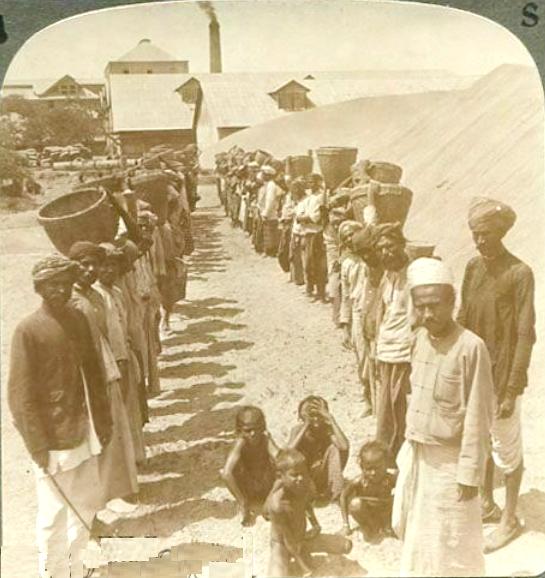
Burma/Myanmar: Economy

Figure 1.--Here we see an early-20th century steeo-view card. The caption read, "Freight handlers and thousands of tons of rice which they have unloaded. Rangoon, Burma." Notice the huge quantity of rice. We believe th rice ha been unladed fron trains to be loadeda board ships for export to Bngal.
|
|
Burma along with with Thailand, Cambodia and southern Vietnam share some of the richest agricultural land in the world. , Rice is believed to have been domesticated in the Yangtze River valley in China (10,000–8,000 BP). Slowly rice culture expanded south to India and Southeast Asia. And nowhere were conditions so favorable for growing rice than Southeast Asia, including Burma. The soil climate, and plentiul water was perfect for bountiful harvests. The earliest trade routes between India and China because of the towering Himaalyas passed through Burma--the earliest appearance of the Burma Road (100 BC). The Mon Kingdom which rose in southern Burma was an important Bay of Bengal trading center. Burma's was essentially a subsistence economy. [Adas] Most of the population was involved in raising rice because of the high yields. Most of the rest of the population was involved in other forms of agriculture. Thhere was no formal monetary system until the reign of King Mindon Min (mid-19 century). Land was legally the possession of the Burmese crown. Burma became involved in the Indian Ocean trade as sea going commerce expanded. The arrival of Europeans brought significant change (16th century). The crown continued to control the economy, but new trading opportunities develped. The crown controlled oil wells, gem mining and teak production. The teak was not just or furniture buolding at the time--it was atrategic mateial, used gor building and repairing ships. Logged teak was a valuable export. It was prized by European shipbuilders, because of its strength and durability. Teak was the most imprtant Burmese export (18th century and into the 19th century), until iron and steel replaced wood. Britain waged wars with the Burmese (beginning in the 1820s). Britain colobized Burma and it became among its wealthiest colonies. Teak continued to be valuable and its agricultural sector produced huge quantities of rice, much of it going to nearby Bengal. It was one of the colonies coveted by Japan as part of its Souther Resource Zone. Japan seized Burma a few months after Pearl Harbor (April-May 1942). It was incorporated into the Japanese Greater East Asia Co-Prospeity Sphere. The promossed prosperity did not materialize. Promises of indepedence were illisionary. Rice production fell as a result of Japanese mismanagement and outright seizures along with increasing brutality. Food shortages developed. American naval victories meant that rice and other material could not be shipped back to Japan. Burma with its highly productive agricultural base was potentially one of the richest countries in the region. The population was educated. The bright expectations of independence after the War were, however, not achieved. In contrast to neigboring Thailand, Burmese authorities at independence decided to pursue socialist and isolationis policies. The result was rather than improving the economy, the economy declined below colonial levels. The country is currently ruled by a brutal military regime which has supressed a popular democracy movement. As a result of coruption and incompetence, the military has reduced most Burmese to poverty.
HBC

Navigate the Boys' Historical Clothing Web Site:
[Introduction]
[Activities]
[Biographies]
[Chronology]
[Cloth and textiles]
[Clothing styles]
[Countries]
[Topics]
[Bibliographies]
[Contributions]
[FAQs]
[Glossaries]
[Images]
[Links]
[Registration]
[Tools]
[Boys' Clothing Home]
Navigate the Boys' Historical Clothing national pages:
[Return to the Main Burmese page]
[Return to the Main Asian page]
[Afghanistan]
[Bangladesh]
[Bhutan]
[Burma]
[Cambodia]
[China]
[India]
[Laos]
[Pakistan]
[Sri Lanka]
[Tajikistan]
[Thailand]
[Tibet
[Turkmenistan]
[Uzbeckistan]
Created: 4:45 AM 6/10/2019
Last updated: 4:45 AM 6/10/2019



